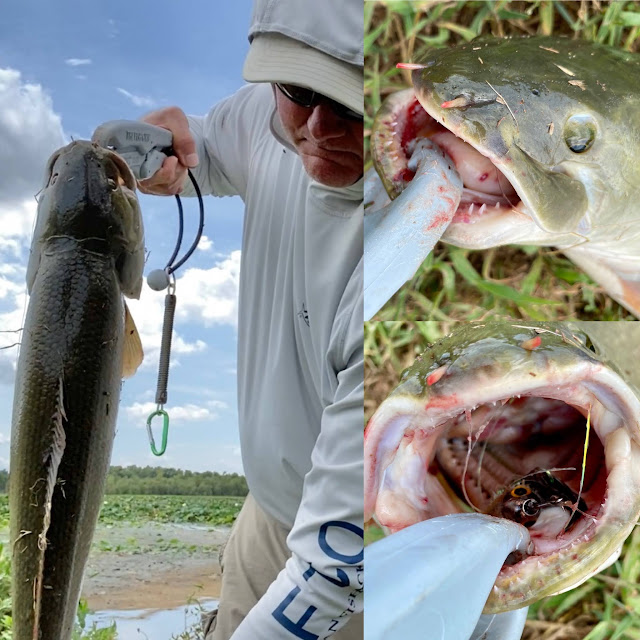***I haven't shared much regarding techniques for quit a while, my recent posts being more about the fish with which I am so enamored. I'm going to start sharing more specifically what I've learned for the various species I've caught.
We all know fish in different waters can behave differently and have different preferences. But I think overall this will give folks who want to try for certain species more info that can hopefully get them started off on the right foot, rather than going blindly. We can all shorten our personal learning curve by first learning from the experience of others.***
This blog post is about Bowfin.
 |
| Bowfin on Fly |
Both species are very similar in the types of habitat they prefer...which is generally lakes, canals, and swampy lowland areas. I've read that Bowfin are common, but not in high numbers anywhere. Backwater areas close to and (at least sometimes) connected to the Mississippi River are great spots, if you live in the Midwest. They seem to like feeding in and around the edges of shorelines and weedy areas. In areas without weeds, look for woody structure such as downed trees.
In my area of St Louis, MO, I've caught Bowfin as early as mid-March. I've caught them as late as mid-October, but they were still biting good then....I just wasn't able to fish for them after that.
I feel it helps immensely if the water is clear enough for sight-fishing....where you can present the fly to an individual fish or spot, and see how they react. But most often I'm fishing very muddy water, likely churned up by the bowfin themselves, since I've cast towards mud clouds and caught bowfin. They must root amongst the bottom at times. Because of the extremely muddy water I'm usually fishing for bowfin, I've experimented with adding fishing scents to flies, hoping to help the fish locate the fly. At times I think it really helps, other times not so much. I've caught plenty of Bowfin with and without scent, so do whatever suits you.
The flies I typically use for Bowfin are large and heavy, plus you want a strong rod and line to help drive the hook home, AND you want to keep Bowfin away from snags in the water. Bowfin are very strong fighters...you'll LOVE 'em! I've caught them on 6wt to 9wt rods...8wt is probably the best wt rod Bowfin. I use a weight forward floating line, and tippet should be a MINIMUM of 12 lb Fluorocarbon. I've caught a bunch of them on that, with surprisingly few break-offs. Although Bowfin have a serious set of teeth hidden amongst their fleshy gums, they seem to be round teeth with points (like a walleye or gar), rather than flat-sided blade teeth like a pike. You do NOT need steel leaders when flyfishing for Bowfin.
Bowfin have large mouths, and will eat topwater flies, such as frog patterns, as well as baitfish patterns, sculpin patterns, and crayfish patterns. I've also caught them on larger nymph-type patterns, such as dragonfly nymph imitations. Some of my favorite flies for Bowfin include Conehead Zuddlers and similar flies, Conehead Bow River Bugger, and the Bass Master fly (the one sold by Big Y Fly Co). Hook size of #2 has been excellent. Overall fly length of about 3" has been a great size. Black has been a great producer in the extremely muddy waters I usually fish, as well as crayfish colors, yellow, and white. A stout, but narrow gauge hook that is super sharp and super strong is EXTREMELY important when targeting Bowfin on flies. The inside of their mouths is nearly solid bone, without much skin that a hook can catch on...so you want to be able to drive that hook into solid bone if possible. It takes good gear and stout line. My favorite hook for Bowfin flies is a Gamakatsu B10S, in about a size 2.
I've also caught Bowfin on silver or gold microjigs that I was using while trying for other species.
 |
| This is one of a number of good flies for Bowfin. Note the length. |
Much of my fishing for Bowfin is done by making reasonably long casts, and hop-and-pause the fly back to me. But I fish some ditches and canals, where Bowfin often congregate near culverts, so I also often catch them by vertically jigging flies around those culvert areas. Sometimes a Bowfin grab the fly and runs. Most often, there will be weight on the line, and then the line slowly moves as the fish swims around with the fly in its mouth. They will hold onto a fly for a surprising length of time, but don't wait too long to STRIP-SET the hook. Don't trout set, because the fly rod will flex enough that it will likely prevent the hook from penetrating adequately.
Also, keep your hands and fingers as far away as possible from a Bowfin's mouth. Use pliers or forceps to remove hooks. Never "lip" a bowfin to hold it like a bass. You may not see its teeth at first, but they have so many teeth and a strong bite-force. I haven't had this issue, but have heard plenty of stories of anglers catching bowfin on lures, and the lure and stout hook get totally crushed by a bowfin's jaws.
 |
| Here's the upper part of a Bowfin's head bones that I found. Don't mess with their teeth! |
Here's a few pics of Bowfins I've caught while flyfishing:
 |
| The one above is a Ruddy Bowfin from Florida. |




















Recently caught my first Ruddy Bowfin - 14 of them on a lure. Can’t wait to have a crack at them on the fly (next time I’m in USA). Thanks for the tips.
ReplyDeleteFun, aren't they? Good luck, Brian!
Delete